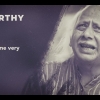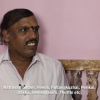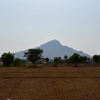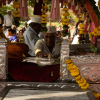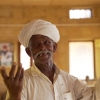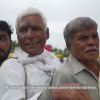Chakravarthy, Pradeep. 2011. Tanjavur:A Cultural History. New Delhi: Niyogi Books.
Kausalya, Rama. 2002. Concert Musical Forms. Tamil Isai Research.
Krishnamachari, Suganthy. 2015. 'Music and Vallalar’s verses', The Hindu 'Friday Review', December 31. Online here (viewed on March 28, 2017).
S. Gopalakrishnan: The three great Chola temples in Tanjavur—Brihadisvara, Gangaikondacholapuram and Darasuram—could you elaborate on the roles these three temples played in the fields of music, dance and other art forms of Tanjavur?
Rama Kausalya: I’ll give some introduction first of all. There are certain factors which make a place a seat of music, fine arts and literature. Number one is the patron. A patron should be there to make the artist to lead a comfortable life so that their output will be great. Number two, the connoisseurs, rasikas should be there. The greatest reward that any artiste gets is the appreciation from the audience. Number three, the artiste. Above all the land should be fertile and peaceful.
Tanjavur was ruled by the Cholas, the Nayakas and then the Marathas. All the three dynasties provided all these conditions for the development of arts. The Cholas ruled Tanjavur from 850 C.E. to 1300 C.E., the Nayakas from 1535 to 1675, and then came the Marathas. The Chola kings, especially Rajaraja Chola I, were great connoisseurs of music and dance. Just two inscriptions found in Tanjavur Brihadisvara temple is enough to testify to his love for arts. Actually he was instrumental in bringing back tevaram music to temples. The tevaram manuscripts were in the Chidambaram temple and he brought them back and kept them in the temple. One of the inscriptions says that he employed 48 tevaram odhuvars or singers at Brihadisvara temple and two accompanying percussion players. Their names, their salaries, everything is there in the inscriptions. So tevaram music is the earliest musical form extant now and Tirugnana Sambandar, one of the tevaram kaaras (poets)—there were three of them, Tirugnana Sambandar, Appar and Sundaramurthi Swami—was Gnanasambandar from Sirkazhi who was only three years old when he began to sing tevaram. The world’s youngest music composer was Gnanasambandar. At the age of five he composed Thodudaiya seviyan. So bringing back tevaram to temples was Rajaraja Chola's first and great contribution to music.
Another inscription talks about Rajaraja appointing dancing girls in the big temple. He brought 400 dancing girls from different parts of the country. We can see the administrative capacities of Rajaraja in this act. The dancers were called theli-cheri-pennugal. He gave each of them a house. The inscriptions give full details like the street name and the door number of each house, the name of the dancer who lived there, from where she came and the salary given to her. One more noteworthy thing we can observe from these two inscriptions is about the appointment. What happened when a dancing girl or a singer died or went away to some other place? He clearly stated in the inscription (setharkum anadesa ponarkum) for the people who died or went away, the next in the family could be appointed. If they were not qualified, the temple committee could appoint a qualified person in that place and he could get the salary that was drawn by his or her predecessor. This was a very clear statement that showed there was never an interruption in the temple services.
Achutappa Nayaka was the second Nayaka ruler. He encouraged young people and was instrumental in bringing the Bhagavata Melam to Melattur. During the Achutappa period, after Krishnadevaraya, the Vijayanagara Empire fell (1565). After this fall, the scholars and artists migrated to Tanjavur because of the Nayaka ruler who was of Telugu descent. So they automatically came, seeking refuge. These dancers and scholars were honoured and were settled in different villages in Tanjavur: Melattur, Saliyamangalam, Teperumanallur, Soolamangalam and Oothukadu. Achutappa Nayaka gave a house and a piece of land with a well, to each of the scholars and artistes who migrated from Andhra Pradesh, the Vijayanagara empire. They continued their literary or artistic pursuits here. And the Bhagavata Mela came into existence here. So Melattur was one of the important places that fostered dance. The word melam means group. Periya melam is group of nagaswaram performers, chinna melam is the dancing group. Bhagavata Mela is the group of dancers, or Bhagavatas, who assembled and enacted the Bhagavata drama. There is another melam, the naiyami melam. That is folk group.
Melattur produced many composers. Actually Melattur played a visionary role in the development of Bharatanatyam. The first alarippu, first shabdam, first tillana, and first swarajathi were composed in Melattur. The names of some composers we have to remember with reverence: Kasinathayya, Narayana Tirtha, Veerabhadrayya, Venkatramana Sastri. Kasinathayya was popularly known as Bharatam Kasinathayya. He was a great natyacharya. He composed, it is said, nine alarippus. His famous shabdams were Manduka and Dashavarata. He also composed shabdams, probably for the introductory part of dance-dramas, and according to tradition they were composed (some of them at least) for the court dancers of Tanjavur and the temple dancers of Melatthur and of course, for the temples. The beauty of the Nandikesvara temple and that of the Vishnu temple were the main themes of the compositions. His service to dance music was great. One of Bharatam Kasinathayya’s disciples, Veerabhadrayya of Melattur, was the originator of swarajathi. That swarajathi was different from the one that we know now. There are three types of swarajathi. Swarajathis of Syama Sastri, swarajathis for the beginners for graded learning of music, and swarajathis for dance conceived by Veerabhadraya. We are grateful to Dr A. Raghavan for unearthing the Huseini swarajathi and publishing it. And Veerabhadraya was the originator of tillanas too. He composed many works, many kirtanas too. And it is believed that one of the disciples of Bharatam Kasinathayya was Panchanathayya, who wrote the Bhagavata Melas of Saliyamangalam. Saliyamangalam dance-dramas were written by one Panchanatha Bhagavathar. He might be the Panchanathayya who was Kasinathayya’s disciple.
And another great person of Melattur was Melattur Venkatarama Sastry, who wrote dance-dramas. The tradition is still there. These Bhagavata Mela dramas, we have to experience it, especially Prahlada. Prahlada is enacted even today on Narasimha Jayanti day. It’s not just an entertainment, it’s an offering to Lord Achuta-Varada by these great artiste families. It is continued till date. Except in Saliyamangalam, in other places there is no dance-drama, especially in Soolamangalam, Oothukadu, there’s no dance troupe, it’s just vanished. But in Melattur it’s still there, and the people who are involved in it are dedicated to it. They come from different parts of the world to assemble here and offer their dedication, their sincere bhakti. It’s their bhakti that makes them come over here to Lord Narasimha. The longest dance-drama in Sanskrit, Krishna Leela Tarangini was composed by Narayana Teertha, whose samadhi is nearby in Thirupoonthuruti where an annual aradhana (worship) festival is conducted in his honour. Narayana Teertha’s disciple was Gopalakrishna Sastri, Gopalakrishna Sastri’s son was Venkatarama Sastri. Gopalakrishna Sastri himself was a composer, he composed four or five dramas. He groomed Venkatarama Sastri and he emerged as a fine dance-drama composer. He composed 12 or 13 dance dramas. Among them, Prahlada and Harishchandra stand unequalled as dance-dramas. The music, especially the handling of such ragas as Ahiri and Ghanta, you cannot get anywhere else, the old ragas rendered in the old, traditional way. The music is excellent. The dance is performed according to Bharata’s Natyashastra. Only male members perform. There are certain reasons to which we agree. And make-up is done according to the role. For light, in the olden days, Krishnamurthy Sharma told me that they planted cut stems of plantain and put cow dung on top of them and above that, placed small earthen lamps. The light from the lamps were enough for them. There would be umpteen lamps kept in two rows. That light was enough. And you can image the serenity of the place when these earthen lamps were there. Now there is electricity and modern make-up materials and mikes. These are today’s conveniences which we cannot avoid, which we cannot change. We can’t go back.
Govinda Dikshitar was the minister who served Achutappa as well as Raghunatha Nayak. He was credited with many charitable works in the region. Raja Veda Patashala of Kumbakonam was his contribution. He renovated many temples. He built many sandhya vandanam mandapams from Mayavaram to Tiruvaiyuru and he is remembered even today with reverence. Ayyanpettai, Ayyankulam and Ayyankadai street all stand in his memory. He was affectionately called as Ayyan. Next ruler was Raghunatha Nayak. Actually the veena we see today was perfected at the court of Raghunatha Nayak. Through the ages veena was undergoing many changes. With this 24 fixed frets and four playing strings and three side strings, this present structure is the contribution of the Raghunatha Nayaka court. The modern veena owes its existence to Raghunatha Nayak. It’s called Saraswathi veena or Tanjavur veena. In fact Tanjavur is one of the places where veenas are manufactured.
And musicological endeavours were also looked after well. Four works came from Tanjavur. According to Prof. Sambamoorthy, on the cultural map of South India, or even India, the brightest spot is Tanjavur. The cream of musical genius lived there. Four-fifths of the repertoire of Carnatic music is from Tanjavur. There were four musicological productions from Tanjavur. Actually Tanjavur guided the whole dance and music world for a period of few centuries. Today’s 72-melakarta scheme of Carnatic music is from Tanjavur (list of parent ragas or reference scales with all seven notes, that represents all possible combinations of the 12 semitonal intervals). Today’s veena is from Tanjavur. Today’s dance repertoire is from Tanjavur. Today’s dance, we call it margam, the item, the sequence of items that ought to be staged in a Bharatanatyam performance—it was not called Bharatanatyam in olden days, it was sadir, before that it was called koothu—the format was perfected in Tanjavur. It is the contribution of the four brothers, the Tanjore Quartet, Chinnayya, Ponnayya, Sivanandam and Vadivelu.
Regarding the instruments, apart from the veena, the violin was brought into the Carnatic music fold by two people. Baluswami Dikshitar, the son of Muthuswami Dikshitar, one of the Music Trinity [editor’s note: Baluswami was the brother of Muthuswami Dikshitar] and Vadivelu. For this contribution, Vadivelu was gifted an ivory violin by Raja Swati Tirunal. Both are instrumental in bringing the violin into Carnatic music. The clarinet was bought into the Carnatic music fold by Mahadeva Nattuvanar. Like this we welcome the foreign instruments also if they are suitable to our music. And there are two traditions of vocal music, one is the veena tradition, the other is the nagaswaram tradition. The veena tradition, we know that Tanjavur is the place of veena. We feel very proud to have the nagaswaram in our region. We don’t say the name of the nagaswaram player, we say only the name of the village. E.g., Rajaratnam Pillai was known by his village’s name Thiruvadudurai. Likewise Thiruvavadudurai, Thiruvizhimedai etc. There are many such names of small villages by which the nagaswaram players are remembered.
To come to the nagaswaram rendering of raga alapana, there used to be temple festivals from late evening to early morning, and my father used to tell me they used to take up one raga for the whole night, or two ragas for the whole night. They would play a particular raga for hours together. But that long alapana that the old timers talk about is missing now. The duration of the temple procession has shrunk and the duration of concerts also has shrunk to a few hours or one and a half hours or two hours. The temple procession also has been limited to maximum four hours, or three hours. But in olden days it would be from late evening to early morning. Many vocal musicians got the raga alapana concept from nagaswaram players. Nagaswaram gamakas, nagaswaram sancharas are very famous, like the veena sancharas. And we have the Tanjavur band by Serfoji Maharaja. There was a band with wooden wind instruments and metal wind instruments, it was popularly known as the Tanjavur band. He was instrumental in organising such a concept. In the field of instruments also our contribution is great.
After Raghunatha came Vijayaraghava Nayak. Vijayaraghava himself was a composer, he composed many yakshaganas. Vijayaraghava Nayaka was a great personality. From the Chola period to the Maratha period, we had royal composers, royal musicologists and royal performers. Because of this, music and dance flourished in this region. And I have forgotten to mention some works on music. One is Sangeeta Sudha; some scholars say it is by Raghunatha, some say it is by Govinda Dikshitar, his minister. Anyhow it is a noteworthy work. Another important work is Chaturdandi Prakasika by Govinda Dikshitar’s son, Venkatamakhin. And the third one is Tulaja’s Sangita Saramrita. The fourth work is Sangraha Chudamani by Govindacharya. These four works led the whole world of music. The principles are laid down in these works. The present-day music themes are drawn from these books. They laid the foundation and the theory for the present day, from the melakartas to the concept of ragas. Today’s janaka-janya system was founded by the Tanjavur musicologists. Vijayaraghava himself was a great connoisseur of music, he himself was a composer; he composed yakshaganas. There were many varieties of dance practised in Tanjavur palace, like Nnata raasyam, Gujjari, Gujarati, Sivalila, Perani etc. Thus there were were umpteen varieties of dance forms found in Tanjavur palace repertoire.
And then came the Maratha rulers. The second Maratha ruler, Shahji (Shahaji I Bhonsle), was a great personality, he was praised as Abhinav Bhoja. Himself a prolific composer, he had to his credit 22 dance-dramas and more than 200 songs both in Telugu and Marathi. Generally, a language gets the official status of a region because it is the language of the ruling dynasty. During the Nayaka period it was but natural that Telugu got pride of place, but even after the advent of the Marathi rulers, the status of Telugu was maintained. They didn’t abolish the previous government’s official language. The scholars and the rulers continued with it. Shahji was proficient in Marathi, Telugu, Sanskrit and Tamil. His productions were in all the languages. His padams are of very high order and his gaya natakas (operas) are very rich. And in Shahji’s time the yakshaganas incorporated some basic elements because of his association with people like Bhaskaraya, the great commentator of Lalitha Sahsranamam and Sridhara Ayyaval, the greatest literary figure of that period and one of those who safeguarded the bhajana sampradaya.
All yakshaganas of Tanjavur had the pundarikams in the beginning like Parvati pataye or Har har mahadeva. Then the todaya mangalam which is an important item in bhajana, became the starting item in the dance-dramas. In Melattur also we can see this pundarikam followed by the todaya mangalam. We can see after the drama is over, people go in procession singing bhajans to the temples. So the bhajana sampradaya had influence on these dance-dramas.
We should talk of the bhajana sampradaya also. The South Indian bhajana sampradaya is one of the contributions. The persons responsible were Govindapuram Bodhendra Swamigal, Marutanallur Sadguru Swamigal, Sridhara Ayyaval of Thiruvisanallur and of course Narayana Teertha of Tirupoonthuruti. So the contribution of these people made Tanjavur a seat of music. Today’s bhajana sampradaya owes much to these people. They formulated and laid down the rules and format of today’s bhajana sampradaya. And since Shahji was closely associated with Sridhara Ayyaval, the dance-dramas of Tanjavur palace were influenced by the bhajana sampradaya. The todaya mangalam started taking an important place in the yakshaganas of Tanjavur palace. Even in the Bhagavatam natakas or dramas we can see the influence of this bhajana sampradaya. In the beginning they start with pundarikam like Nama parvati pataye. It is followed by todaya mangalam like Jaya janaki ramana and at the end they go in procession singing bhajana songs to their temples. So the influence of bhajana sampradaya has been there from the Shahji period.
Shahji was closely associated with scholars as well as musicians, poets, everybody. As I said earlier he was praised as Abhinava Bhoja. His court was full of literary as well as fine arts people, scholars or vidwans. He had close association with Bhaskararaya, the commentator of Lalitha Sahsranamam, Sridhar Ayyaval, the great literary figure of that period, and poets like Vasudeva Kavi, Rama Bharati, Abhusahay Bharati—so many poets. And he himself was a good composer in Marathi and in Telugu. He wrote 22 dance-dramas. In Tanjavur most of the temples gave place for these dance-dramas. Dance-dramas like Tyagesar Kuravanji and Sankara Pallaki Seva Prabhandam by Shahji was enacted annually at Tiruvarur temple, Sarvendra Bhupala Kuravanji was enacted at Tanjavur temple. Like that the dance-dramas were enacted in many temples during their annual brahmotsavams (festivals).
Then one more thing, the kuravanji natakas. A kuravanji nataka is very peculiar in its structure. The first half is very classical, but the second part is light. It is because of the entry of gypsy woman in the second half. The first part strictly contains only classical compositions while the second part is with folk music; so it is a combination of folk and classical. Compared to the gaya natakas the kuravanji natakas appealed greatly to the masses. The first kuravanji nataka, according to researchers, was Kumbhesar Kuravanji by Papanasa Mudaliar and this kuravanji was enacted at Kumbhesar temple and other venues also. According to scholars this Kumbhesar Kuravanji was the earliest kuravanji drama. This is staged annually at the Kumbhesar temple and is a very interesting piece amongst the kuravanji natakas.
After Shahji, another noteworthy ruler was Tulaja. He was a great musicologist. Sangita Saramrita was the musical treatise written by Tulaja himself. Next came Serfoji the Great. We know that the band was his and he patronised great many musicians of the region. If we take the name of any musician belonging to late 18th or early 19th century, we can find that he was attached to the Tanjavur court or Serfoji’s court.
The hundred years from 1750 to 1850, was the golden period for music all over the world. From Beethoven and Mozart to the Trinity of Carnatic music, great musicians lived during that period. And the Maratha rulers brought three things to Tamil Nadu, to the Chola country. First is the art of harikatha, the second is the poikkal kudirai (dummy horse), and the third is the kondalam, a percussion instrument.
Harikatha is a very interesting art. There are many story-telling traditions in India, particularly in Tamil Nadu, but harikatha is very peculiar. This particular art cannot be learned, it should be inborn. Nobody can learn harikatha from a teacher. It would be very difficult to do so. Because a harikatha performer should have proficiency in Vedas, Sastras, music etc. They should know (everything), from the Upanishads to common folk tunes. They should be well-versed in music. Above all they should know the psychology of the audience. Harikatha was brought to Tanjavur by the kirtan performers of Maharashtra. But our people adapted the Maratha tradition to suit ours. This started with someone called Krishna Bhagavatar. He was the pioneer, the originator of Tamil Nadu’s harikatha tradition. After listening to the traditional kirtan performance, he adapted it in Tamil. So this harikatha tradition started in Tamil Nadu from Krishna Bhagavatar. For that reason they needed lot of compositions—for stories from the Bhagavata, the Ramayana and the Mahabharata.
S.G.: Which period did Krishna Bhagavatar belong to?
R.K.: Krishna Bhagavatar lived during the Maratha period, the Serfoji period. And they needed a lot of songs for harikatha performances. There were a lot of charitra kirtanas. All the composers began to compose charitra kirtanas. The advent of print was in 1835. In 1835 the first Tiruvasagam was printed. We were permitted to print in vernacular languages. So these productions came into existence because of the print media. We were able to get many of the charitra songs, not its music of course, but the verses. So every production of that period got published. Then the charitra kirtanas. The first opera in Tamil was Arunachalakavi’s Ramanataka kirtana. The concept of opera in our country is different from that of the west. It’s quite different—the drama, the dance, everything is different.
Arunachala Kavirayar’s Ramanatakam was composed at first for pravachanas. Then he adopted it to dance and music. Then another noteworthy composition was Gopalkrishna Bharati’s Nanadanar Charitram. Because of the Maratha rulers, the Maratha vidvans also came here. Someone called Kokilakantha Mersuswami, his voice was so sweet that he was called Kokila-kantha ('voice like that of the koel bird') Mersuswami. Gopalakrishna Bharati learnt the Maratha forms from him and was able to introduce them here. There were many Maratha forms like Ovi, Khadga etc. He adopted those Maratha forms to our traditional repertoire. For example, in Nandanar Charitram kirtana you will see all the Maratha forms incorporated. Then there were composers like Mahadeva Vaidyanathayyar…the Khanda Purana kirtana, the stories in the Ramayana, the Mahabharata or the Bhagavatam were adopted in the form of kirtanas. This was a great contribution of Tanjavur. And there were many composers like Subbaramayyer…he was a great padakara. And especially during the 19th century there were many Tamil composers. So it was a golden age for Tamil compositions.
Shahji’s period is considered the golden period for the Carnatic music Trinity—Tyagaraja, Muthuswami Dikshitar and Syama Sastry—they perfected the kriti format with all the decorative angas. Because of the disciples of these composers, they became very popular. Tyagaraja the saint-composer of Tiruvaiyaruru, his compositions are in Telugu and Sanskrit, most of them are in Telugu. They are in very simple Telugu and easily understandable and the style is both majestic and simple. But Muthuswami Dikshitar’s style is very grand, the tempo is very slow and very grand. It is stuffed with decorations. And since he lived in Benaras for quite sometime, the Hindustani influence is also seen, and he employed Hindustani ragas in his compositions. Syama Sastry was the traditional archaka (priest) of Bangaru Kamakshi temple in Tanjavur and (the style of) his compositions is between Dikshitar’s and Tyagaraja’s. As a lay bhakta (devotee) his compositions are direct and simple. They directly address Kamakshi. Muthuswami Dikshitar’s father, Ramaswami Dikshitar came and lived in Tiruvidaimarudur and Tiruvarur. He was the creator of the Hamsadhwani raga. He perfected, fixed the composition ragas the nadaswaram players played during the Tiruvarur temple procession. He fixed the songs which were to be sung in different places. He composed ragamalikas, his compositions are very grand and his son also followed his tradition. Muthuswami Dikshitar’s and Syama Shastry’s families were all musicians and composers. But Tyagaraja’s sishya-parampara is huge, he has a very long list of disciples who were musicians and composers themselves.
So there were a lot of composers in Telugu, Sanskrit and Tamil languages. Since Telugu was the official language during the Nayaka period it was but natural that the productions were in Telugu. Tyagaraja was Telugu but even the Tamil poets composed in Telugu and Sanskrit during that period and the period to follow. Sirkazhi Moovar, Arunachala Kavirayar, Muthuthandavar, who was the pioneer in Tamil padas. Arunchala as I said was the first to compose an opera in Tamil, Ramanatakam.
Then there were many composers after them. Then came Gopalakrishna Bharati. Papanasam Sundaram was before Gopalakrishna Bharati. And Subbaramayyer was famous for his padas. Ghanam Krishna Iyer was a great musician as well as a padakara (poet). Vedanayakam Pillai, Vedanayakam Sastri of Tanjavur, Subbarama Iyer. Then comes a very long list of musicians and composers. Pallavi Doraisamy Iyer, Pallavi Gopala Iyer, the composer of the majestic Kalyani raga, ata tala varnam 'Vanajakshi', who lived in Tiruvaiyaru, all were great contributors to Carnatic music. And there were many musicians like Todi Sitaramayya, Sankarabharanam Narasayya, the name prefixed to theirs indicated that they were adept in that particular raga.
There is an interesting story about Todi Sitaramayya. Once he needed money and he had nothing to pledge and so he pledged the Todi raga. So he got money. In the subsequent concerts the audience wanted him to sing Todi raga but he refused. One day they found that it was pledged and one of the patrons went to the shop, paid the money and brought back the todi raga to Todi Sitaramayya, and only then was he free to sing the raga.
We have heard many stories about Tansen who could control nature with his singing. Like that there are stories in Tanjavur also. One vocalist’s title was Chellakattu, which means cool breeze. Chellakattu Krishna Iyer. On one hot summer evening, it was very sultry and he sang mazhaimarta raga and suddenly there was a breeze. From the Nayaka period we had had a long list of musicians. Badagapayya, there is a street in his name in Tanjavur. Veena Kalahastayya, Veena Perumal Ayya. Pallai Gopalayyer was a big performer. Veena Vaidyanathayyer, Dasavadyam Krishnaiyyer who could play ten instruments, and Gotuvadyam Sakha Ram Rao. Like that we have a long list of musicians. They could sing a particular raga for several days. There were musicians who could sing a raga for several days. And they were adept at manodharma sangeetham. There was Pacchimini Madhipriyar—he was called Tanavarnam Margadarsi. His varnam—'Viriboni' in Bhairavi raga—there’s no composition that equals it. All the dasavidha panchadasa gamakas can be seen in that varnam. After Independence the scene is different because the economic conditions forced the musicians to migrate to cities. During that period Maha Vaidyanathan as well as Pattanam Subramania Iyer were in Tiruvaiyaru. See, Maha Vaidyanathan got the title 'maha' at the age of 14.
Anayya was a great composer of that period. Like Maha Vaidyanathan, Anayya also composed in both Tamil and Telugu. And Maha Vaidyanathan stayed in Tiruvaiyaru but Pattanam Subramania Iyer migrated to Chennai. He was Tiruvaiyaru Subramania Iyer at first, but because he migrated to Chennai, he came to be called Pattanam Subramania Iyer (Chennai was Pattanam then). Actually he belonged to Tiruvaiyaru. Thus from the 1840s and 1850s the vidvans began to migrate to Chennai. Tanjavur has produced great composers, great musicians and great patrons. Even during the 20th century, especially the first half of the 20th century, the art well as literature in Tanjavur was noteworthy.
We should remember the contributions of Abraham Pandithar especially. Abraham Pandithar, though he belonged to a different district, came down to Tanjavur and settled there. He started his career as a schoolteacher but he received herbal medicinal advice from a Karunandhar yogi and he established his own hospital and a production unit of those herbal medicines. Those medicines were very popular. All the wealth he earned from selling the medicines he spent on music research. That’s why he’s remembered now. He was a very affectionate person, loved by all people of Tanjavur. Abraham Pandithar researched on Tamil music. He was the first person to research on Tamil music, especially the music in the Silappathikaram. He concentrated on srutis. He established that srutis found in the Silappathikaram are the right ones.
With his own money he convened six music conferences, the first of their kind in India. The six music conferences were held in Tanjavur and in those conferences all aspects of music were discussed, especially the srutis. The Silappadikaram was discussed. And he along with his daughters attended a music conference in Baroda, I think in 1916 (at the All India Music Conference) and established that in Tamil music, the srutis are correct. His six conferences were between 1912 and 1914. Combining all his research material, he brought out a huge volume called Karunamirdha Sagaram (showing the book) This is that book. It is very difficult even to carry this book. There are more than 1200 pages and that too with photographs. Imagine the year of its publication was 1917! Today it is very easy with all the digital facilities to print a book. But in those days even with his own press, it was a huge task.
This book deals with Tamil music. And he has also dealt with music history, the Cholas, the Nayakas and the Marathas and their contributions. And the first 'Who’s Who' of musicians and composers of music is found in this book. I think this must be the first directory on musicians, there’s a portion set apart for it. And it is called Karunamirdha Sagaram. And the calculations, we are not even able to follow the complex calculations, it is amazing to see the kind of printing and material of this book. And he has included the research as well as the participants in all the six music conferences, even the photographs, the Baroda conference and the people who attended those conferences. Everything is recorded in this book. He has compared the Lakshana Granthas written in Sanskrit and has compared the North Indian music books also and declared that the sruti of our line the right one. And of course there may be some difference of opinion about the basic raga, the basic melakarta of Tamil music. He says that Sankarabharanam was the first raga. But later researchers say it was Harikamboji. So Abraham Pandithar’s name is remembered reverentially by the researchers of music even today. Tanjavur is proud of this great person.







